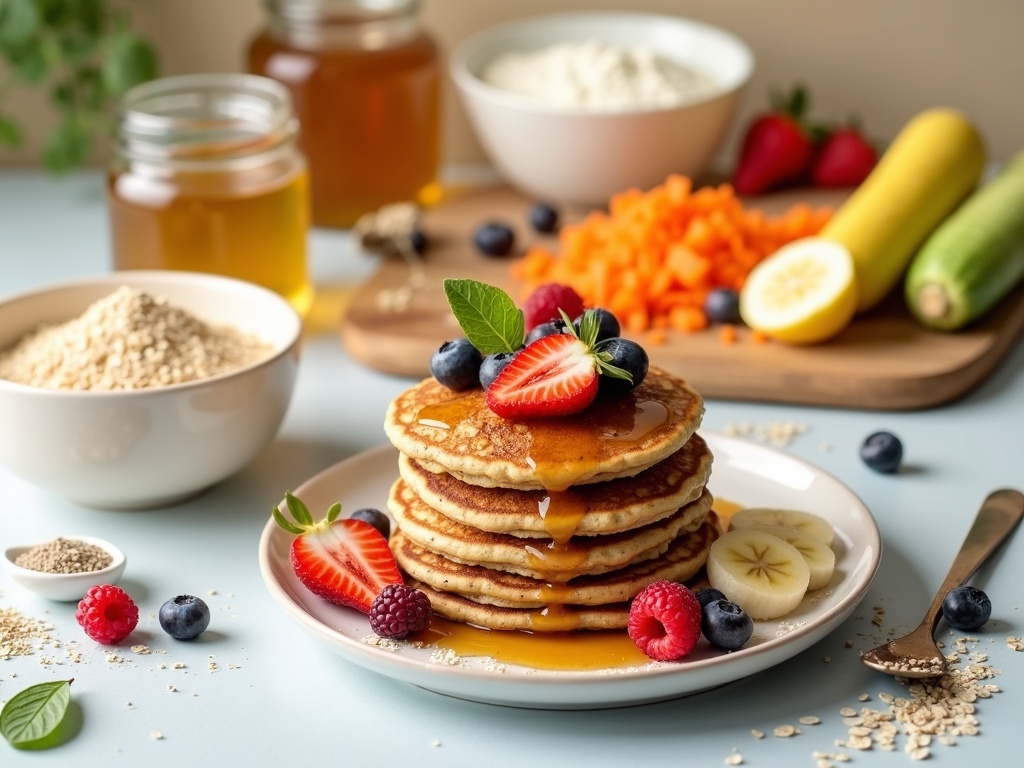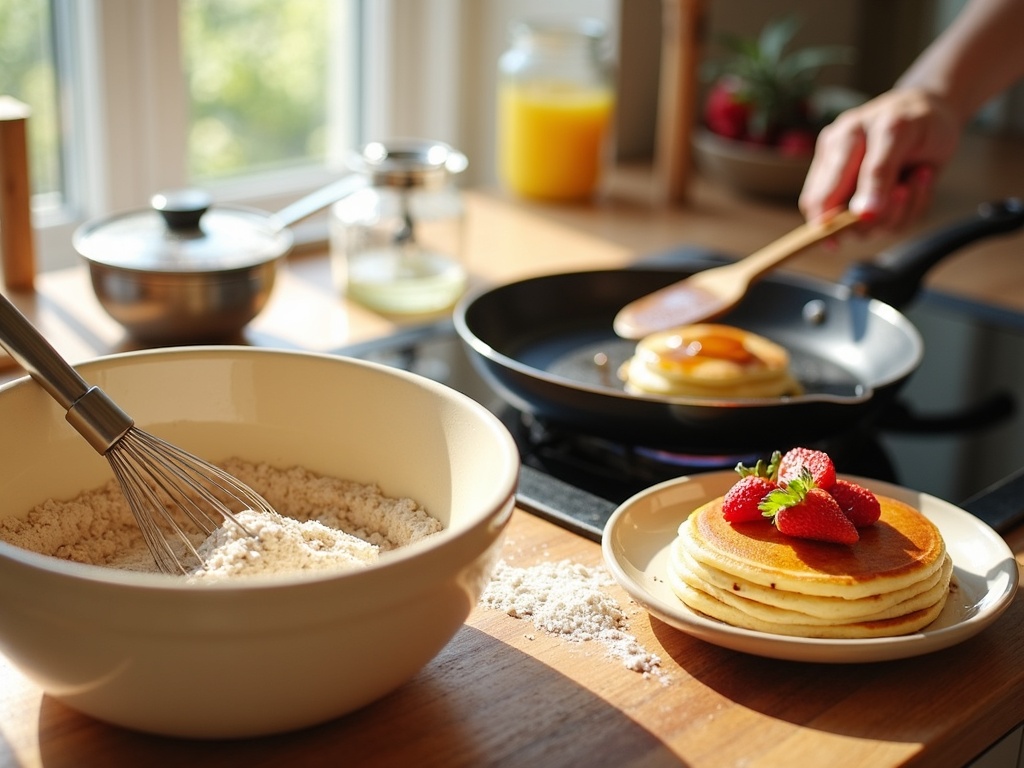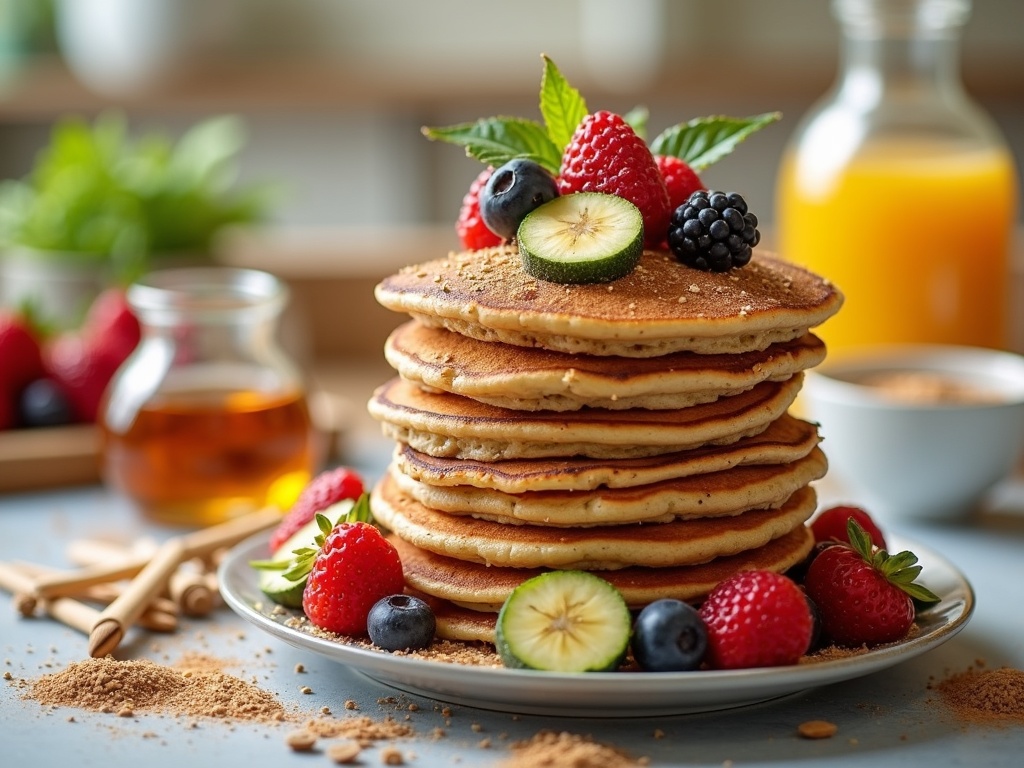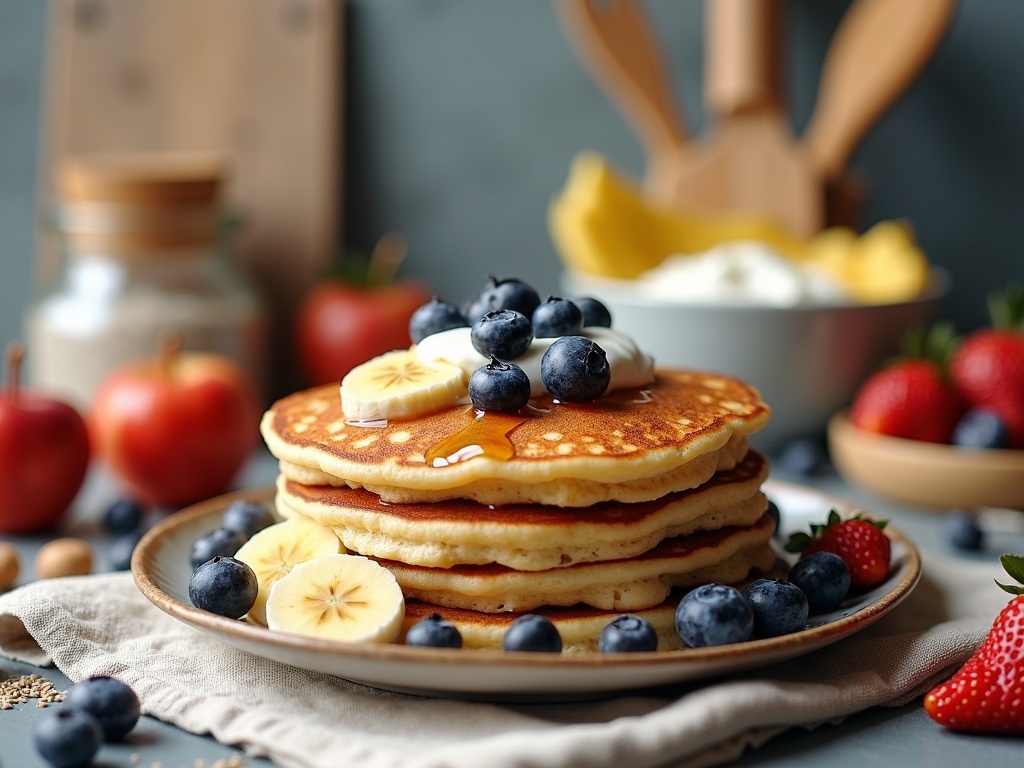Healthy pancakes transform a breakfast classic by using whole grain flours, natural sweeteners, and fiber-rich additions that enhance nutrition while cutting calories. These better versions deliver sustained energy and adapt to different dietary preferences with fruit, vegetable, and protein additions—all while maintaining great taste.
Find In This Article
Key Takeaways
- Healthy pancake recipes typically contain 150-250 calories per serving, nearly half the calories of traditional versions while providing 3-5 times more fiber.
- Whole grain flours like wheat, oat, or spelt offer essential nutrients including B vitamins, vitamin E, and minerals that are missing from refined white flour.
- Adding protein through Greek yogurt, cottage cheese, or protein powder transforms pancakes into a complete meal that prevents mid-morning hunger.
- Natural sweeteners such as maple syrup, honey, or mashed banana reduce sugar content while adding subtle flavors and additional nutrients.
- Proper preparation techniques, like not overmixing the batter and cooking at medium heat, ensure fluffy texture even with healthier ingredients.
Why Healthy Pancakes Are Better For You
I’ve found that making the switch to healthy pancakes has been a game-changer for my morning routine. Traditional pancakes, while delicious, often pack a hefty caloric punch that can leave you feeling sluggish. Healthy pancake recipes typically contain just 150-250 calories per two pancakes, nearly half the calorie count of their traditional counterparts.
Nutritional Advantages of Healthy Pancakes
The foundation of any good healthy pancake starts with whole grain flour. I’ve discovered that whole wheat, oat, or spelt flour provides approximately 4-5g of fiber per 1/4 cup, a significant upgrade from refined white flour. This fiber boost isn’t just good for digestion—it helps maintain steady blood sugar levels throughout the morning.
Natural sweeteners are another key improvement in homemade pancakes with a healthy twist. By replacing refined sugar with options like pure maple syrup, honey, or mashed banana, I can drastically reduce the sugar content while keeping that sweet flavor I crave. These natural alternatives also bring their own subtle flavors and additional nutrients to the breakfast table.
The higher fiber content in healthy pancakes is perhaps their most practical benefit. I’ve noticed I stay fuller much longer after eating these, which helps prevent mid-morning snacking and keeps me satisfied until lunch. This is particularly helpful on busy days when I don’t have time for multiple meals or snacks.
Adding fruits and vegetables to pancake batter takes the nutritional profile to another level. I regularly fold in berries, grated apples, or even shredded carrots and zucchini to create unique pancake variations that pack extra vitamins, minerals, and antioxidants. These additions contribute natural sweetness and moisture while boosting the overall nutrient density of my breakfast.
How to Make the Transition to Healthier Pancakes
Moving to healthier pancakes doesn’t have to happen overnight. I started by making simple swaps in my regular pancake recipe:
- Replace half the white flour with whole wheat or oat flour
- Reduce sugar by 25% and add cinnamon for flavor
- Incorporate one mashed banana or 1/4 cup applesauce for moisture and natural sweetness
- Add a tablespoon of ground flaxseed or chia seeds for omega-3 fatty acids
Once I got comfortable with these changes, I began exploring more creative options for healthy breakfast pancakes. Greek yogurt adds protein and creates a tender texture. Nut butters contribute healthy fats and richness. Even adding a scoop of protein powder can transform basic pancakes into a post-workout powerhouse meal.
The beauty of healthy pancakes is their versatility. I can customize them based on my nutritional needs and flavor preferences. Whether I’m looking for a protein-packed option after exercise or a fiber-rich meal to start a busy day, there’s a healthy breakfast meal pancake recipe that fits the bill.
Protein is another consideration where healthy pancakes shine. By incorporating ingredients like Greek yogurt, cottage cheese, or protein powder, I can create a more balanced breakfast that helps maintain muscle and provides lasting energy. Traditional pancakes typically lack this protein component, making them less satisfying in the long run.
For anyone new to healthy pancake making, I recommend starting with simple easy healthy breakfast recipes that use familiar ingredients. The transition feels less drastic, and you’re more likely to stick with it. As your taste buds adjust, you can gradually incorporate more whole foods and experiment with different flours and add-ins.

Essential Ingredients for Perfect Healthy Pancakes
Making healthier versions of traditional pancakes is easier than you might think. I’ve found that with a few simple swaps and additions, you can enjoy delicious pancakes that don’t sabotage your nutrition goals. The key is starting with the right foundation of wholesome ingredients.
Building Your Better Batter
The base of any good pancake recipe begins with flour, but not all flours are created equal. I recommend using 1 cup of whole grain flour rather than refined white flour. Whole wheat, oat, or spelt flour provides more fiber, protein, and nutrients while creating a satisfying texture for your fluffy pancakes. These alternatives give a slightly nutty flavor that pairs beautifully with natural sweeteners.
Speaking of leavening, 1-2 teaspoons of baking powder will give your pancakes that perfect rise. For binding, one large egg works wonders, providing protein and helping create structure in your batter. If you’re looking for a plant-based option, you can substitute with a flax egg (1 tablespoon ground flaxseed mixed with 3 tablespoons water).
The liquid component is just as important – about 3/4 cup of low-fat milk creates the right consistency. Plant-based alternatives like almond, oat, or soy milk work perfectly for a dairy-free version of these homemade pancakes.
Rather than loading up on sugar, I’ve found natural sweeteners make all the difference. A tablespoon of honey adds only 64 calories while providing sufficient sweetness. Maple syrup, agave nectar, or date syrup are excellent alternatives that complement the whole grain flavors.
For an extra nutrition boost, consider these additions to your batter:
- A medium banana (approximately 100 calories) mashed into the mix adds natural sweetness and creates moisture without extra oils
- A tablespoon of chia seeds provides omega-3 fatty acids and extra fiber
- Ground flaxseeds not only offer omega-3s but also contribute to a pleasant texture
- A dash of cinnamon or vanilla extract enhances flavor without adding calories
The beauty of pancake recipes is their versatility. You can fold in berries for antioxidants, chopped nuts for protein and healthy fats, or even grated zucchini or carrots for hidden vegetables.
I’ve discovered that preparing the batter properly makes a significant difference. Mix your dry ingredients thoroughly first, then create a well in the center before adding your wet ingredients. This prevents overmixing, which can make pancakes tough instead of fluffy.
For those busy mornings, you can pre-mix the dry ingredients and store them in an airtight container. This makes whipping up easy healthy breakfast pancakes much quicker when you’re short on time.
These nutrient-dense pancakes make an excellent foundation for a healthy breakfast that will keep you satisfied until lunch. Top them with fresh fruit, a dollop of Greek yogurt, or a light drizzle of honey rather than traditional syrup to keep the calorie count reasonable.
By focusing on whole food ingredients, you’ll create pancakes that not only taste amazing but also provide sustained energy and valuable nutrients. The right balance of protein, fiber, and natural sweetness makes these healthy breakfast meals a smart choice for anyone looking to enjoy a favorite morning treat without compromising their nutrition goals.
Your Step-by-Step Cooking Guide
Creating the perfect healthy breakfast starts with mastering the art of making delicious pancakes. I’ve put together this comprehensive guide to help you nail the technique from start to finish.
Perfecting Your Pancake Batter
The secret to fluffy and nutritious pancakes lies in how you mix your ingredients. First, combine all dry ingredients in a large bowl. This typically includes flour (or your preferred healthy alternative like whole wheat or oat flour), baking powder, a pinch of salt, and any dry spices.
In a separate bowl, whisk together your wet ingredients until smooth. These might include milk (dairy or plant-based), eggs, a touch of honey or maple syrup, and vanilla extract. For extra nutrition, you can add mashed banana or unsweetened applesauce.
When combining wet and dry ingredients, use a light hand. Stir just until incorporated—about 10-12 strokes is usually enough. You’ll still see a few lumps, and that’s perfectly fine! Overmixing is a common mistake that leads to tough, flat homemade pancakes.
Let the batter rest for 5-10 minutes. This allows the gluten to relax and the baking powder to activate, resulting in fluffier pancakes.
Cooking Techniques for Perfect Results
Pan temperature is crucial for evenly cooked pancakes. Start with a non-stick pan or griddle over medium heat. To test if your pan is ready, sprinkle a few drops of water on the surface—they should dance and sizzle but not instantly evaporate.
Before pouring your first pancake, prepare the cooking surface. I like to brush it lightly with a small amount of coconut oil or give it a quick spray with cooking oil. This ensures your easy healthy breakfast won’t stick to the pan.
Pour about 1/4 cup of batter for each pancake, leaving plenty of space between them. The most common mistake is flipping too early. Wait until bubbles form across the surface and the edges begin to look set—this usually takes about 2 minutes. These visual cues are your signal that it’s time to flip.
Use a thin spatula and flip with confidence in one swift motion. Cook for another 1-2 minutes on the second side until golden brown. The second side typically cooks faster than the first.
If you’re making several batches, avoid these common pitfalls:
- Turning the heat too high (results in burnt outsides and raw centers)
- Pressing down on pancakes with the spatula (squeezes out air and makes them dense)
- Using a cold pan for the second batch (leads to uneven cooking)
- Adding more oil between every pancake (makes them greasy)
For healthy breakfast meals with pancakes, maintaining medium heat throughout the cooking process is essential. Too low, and your pancakes will be pale and soggy; too high, and they’ll burn before cooking through. If your pancakes are browning too quickly, lower the heat slightly.
For special varieties like ube mochi pancakes or other specialty flavors, the same cooking principles apply, though you might need to adjust cooking time slightly depending on the batter thickness.
Remember that the first pancake is often a “test pancake” that helps you gauge your pan’s temperature. Don’t be discouraged if it isn’t perfect—adjust as needed for the rest of the batch.
Once cooked, serve immediately for the best texture and flavor. If you need to keep pancakes warm while cooking the full batch, place them in a single layer on a baking sheet in a 200°F oven.
With these techniques, you’ll create perfectly cooked, fluffy pancakes every time—a delicious foundation for your healthy breakfast routine.

Creative Healthy Variations to Try
I’ve discovered that pancakes don’t have to be a guilty pleasure when you get creative with healthier ingredients. Making nutritious tweaks to traditional recipes has allowed me to enjoy this breakfast favorite more often without compromising my health goals.
Reimagined Pancake Recipes for Every Diet
For those following a plant-based lifestyle, vegan pancakes are surprisingly easy to make. I substitute eggs with flaxseed or chia “eggs” by mixing 1 tablespoon of ground seeds with 3 tablespoons of water and letting it sit for 5 minutes until it develops a gel-like consistency. This works beautifully as a binder while adding omega-3 fatty acids and fiber to your pancakes.
Protein pancakes have become my go-to after morning workouts. Adding a scoop of protein powder to the batter boosts the nutritional profile significantly. Alternatively, blending cottage cheese into the mix creates a protein-rich, creamy texture that’s perfect for a satisfying healthy breakfast that keeps hunger at bay until lunch.
Gluten-free pancakes don’t have to be dense or flavorless. I’ve had great results using almond flour for a nutty, protein-rich option or coconut flour for a slightly sweet flavor profile. Remember that coconut flour absorbs more liquid, so you’ll need to adjust your wet ingredients accordingly—typically using more eggs or liquid than traditional recipes.
The right flavoring can transform basic homemade pancakes into something special without adding many calories. A splash of vanilla extract and a generous sprinkle of cinnamon not only enhance the taste but also offer health benefits—cinnamon helps regulate blood sugar levels, which is particularly useful when enjoying a carb-based breakfast.
For texture and nutrition boosts, I love incorporating various add-ins to my pancake batter. Here are some of my favorite combinations:
- Blueberries and lemon zest for antioxidants and bright flavor
- Chopped apples and walnuts for crunch and heart-healthy fats
- Mashed banana and a sprinkle of dark chocolate chips for a treat that still packs nutritional value
- Shredded carrots and crushed pineapple for a tropical spin on easy healthy breakfast options
- Pumpkin puree with pumpkin spice for a seasonal favorite rich in vitamin A
I’ve found that ube mochi pancakes offer a unique twist with their vibrant purple color and chewy texture, making them a fun option for those looking to experiment with different cultural influences.
For toppings, I skip the traditional syrup loaded with refined sugars. Instead, I opt for fresh fruit compotes made by simmering berries until they break down into a natural sauce. Greek yogurt with a drizzle of honey provides protein and probiotics. Nut butters add healthy fats and staying power to keep me full through the morning.
When creating healthy breakfast meals centered around pancakes, I pair them with complementary sides like a small fruit salad or a hardboiled egg to round out the nutritional profile.
The beauty of these healthy variations is their versatility—you can mix and match ingredients based on what’s in your pantry or dietary needs. Whether you’re managing specific health concerns or simply trying to incorporate more nutrients into your diet, these pancake adaptations offer something for everyone without sacrificing the comfort and joy of this beloved breakfast classic.
Smart Storage and Serving Solutions
Making a batch of healthy pancakes ahead of time can save precious morning minutes and keep your nutritious breakfast routine on track. I’ve found that proper storage is key to maintaining their flavor and texture while having smart serving strategies ensures they remain a healthy option.
Storage Techniques That Preserve Quality
When storing homemade pancakes in the refrigerator, let them cool completely before placing them in an airtight container with parchment paper between each pancake to prevent sticking. They’ll stay fresh for up to 5 days this way, making them perfect for busy weekday mornings.
For longer storage, freezing is your best friend. I layer cooled pancakes between sheets of parchment paper, place them in a freezer-safe container or resealable plastic bag, and they stay good for up to 2 months. This method works brilliantly for pancake recipes of all types, including specialty options like ube mochi pancakes.
Meal prep has become my Sunday ritual, and pancakes are a staple. I make a double batch, portion them into daily servings, and store them properly. This approach ensures I have a quick healthy breakfast ready to go, eliminating the temptation to skip this important meal or grab something less nutritious.
Nutritious Toppings and Serving Ideas
The toppings you choose can transform your pancakes from merely good to nutritionally outstanding. Instead of drowning your stack in syrup, try these healthier alternatives:
- Greek yogurt makes an excellent topping that adds protein and creaminess without excessive sugar. A dollop on top of warm pancakes creates a delightful contrast of temperatures.
- Fresh fruits add natural sweetness, fiber, and vitamins. Berries, sliced bananas, or diced apples bring color and nutrition to your plate. I love creating a rainbow of fruits across my easy healthy breakfast pancakes.
- Nut butters provide healthy fats and protein. A tablespoon of almond or peanut butter melting over warm pancakes creates a satisfying, nutrient-dense topping that keeps hunger at bay until lunch.
For additional protein, consider serving your pancakes with:
- A side of scrambled egg whites or tofu scramble
- A sprinkle of hemp seeds or chopped nuts
- A small smoothie made with protein powder and plant milk
- A side of cottage cheese mixed with cinnamon and a touch of honey
These protein-boosting strategies transform your pancakes into a complete healthy breakfast meal that provides sustained energy.
For reheating refrigerated pancakes, a quick 15-20 seconds in the microwave works well. For frozen pancakes, either let them thaw overnight in the refrigerator or reheat them directly from frozen in a toaster on a low setting. This preserves their texture better than microwaving from frozen.
When serving pancakes for guests or special occasions, I create a toppings bar with various healthy options. This interactive approach lets everyone customize their stack while still keeping nutrition in focus.
By combining smart storage techniques with thoughtful serving ideas, healthy pancakes can become a convenient, nutritious, and delicious part of your regular breakfast rotation, proving that good planning makes healthy eating much simpler.
Health Benefits and Nutritional Impact
Healthy pancakes have evolved far beyond mere breakfast alternatives – they’re nutritional powerhouses offering significant health benefits compared to their traditional counterparts. I’ve discovered that making strategic ingredient swaps can transform this beloved breakfast into a genuinely nourishing meal.
Nutritional Superiority Through Smart Ingredients
The fiber content in healthy breakfast pancakes typically exceeds traditional versions by 2-3 times. While conventional pancakes made with refined white flour contain minimal fiber (usually less than 1 gram per serving), whole grain versions can deliver 3-5 grams per serving. This fiber boost supports digestive health and creates longer-lasting satiety, helping to manage hunger throughout the morning.
Whole grain flours used in homemade pancakes offer impressive nutritional advantages. They retain the bran and germ portions of the grain, which house essential nutrients like:
- B vitamins crucial for energy metabolism
- Vitamin E for antioxidant protection
- Minerals including iron, zinc, and magnesium
- Plant compounds with anti-inflammatory properties
One of the most compelling aspects of healthy pancakes is their adaptability for different dietary requirements. I’ve successfully created versions that cater to:
- Gluten-free diets using almond, coconut, or oat flour
- Dairy-free needs by substituting milk with almond, oat, or coconut alternatives
- Vegan requirements by replacing eggs with flax or chia “eggs”
- Low-carb approaches using coconut flour or almond meal
Natural sweeteners provide significant benefits compared to refined sugar. Maple syrup contains manganese and zinc, while honey offers antimicrobial properties. Date syrup packs potassium and iron, and coconut sugar includes inulin fiber that doesn’t spike blood sugar as dramatically. These natural alternatives generally have lower glycemic indexes than white sugar, resulting in more stable energy levels after enjoying your pancakes.
The incorporation of fruits and vegetables into pancake batters substantially boosts their nutritional profile. For instance, adding mashed banana increases potassium content while reducing the need for added sweeteners. Grated zucchini or carrots introduce additional fiber, vitamins A and C, and moisture without overpowering flavor. Berries introduce powerful antioxidants that fight cellular damage. Even options like ube mochi pancakes can contribute unique nutritional elements like anthocyanins from the purple yam.
Protein enrichment represents another significant advantage of healthy pancakes. By incorporating Greek yogurt, you’ll add roughly 10-15 grams of protein per cup used. Nut butters contribute not only protein but heart-healthy fats. Egg whites can boost protein content while keeping fat content lower for those monitoring their fat intake.
For those seeking an easy healthy breakfast with staying power, protein-rich pancakes help maintain stable blood sugar and provide the building blocks for muscle maintenance and repair. This makes them particularly valuable for active individuals or as part of a balanced post-workout meal.
The strategic use of spices like cinnamon, nutmeg, and ginger adds flavor complexity while potentially offering blood sugar regulation benefits. Cinnamon, in particular, has been associated with improved insulin sensitivity in some studies.
Healthy pancakes can be part of a broader approach to healthy breakfast meals that prioritize nutrient density. When paired with protein sources like Greek yogurt and topped with fresh fruit instead of syrup, they transform from an occasional treat to a genuinely nutritious meal option that supports overall health goals while still delivering the comfort and satisfaction we all crave from this beloved breakfast classic.

Sources:
American Heart Association – Whole Grains and Fiber
Whole Grains Council – Health Benefits of Whole Grains
U.S. Department of Agriculture – FoodData Central
EatingWell – Healthy Eating

